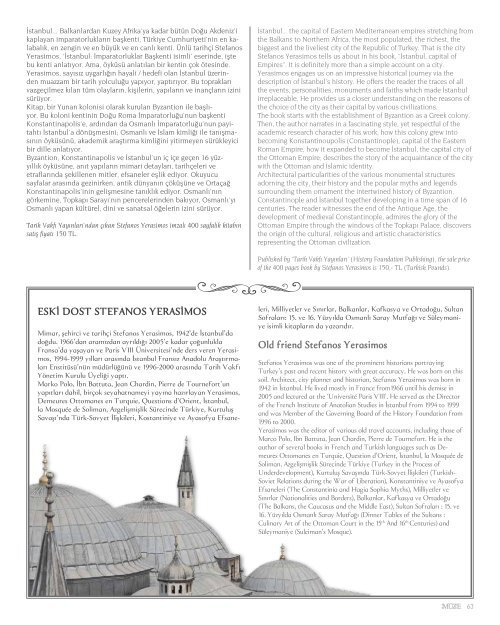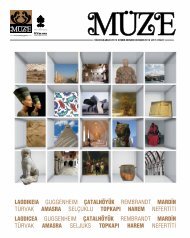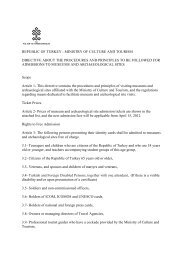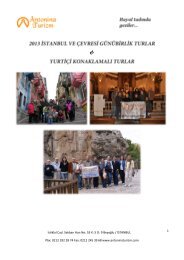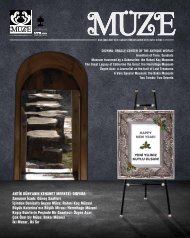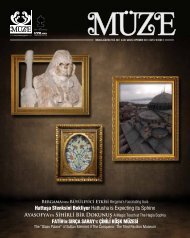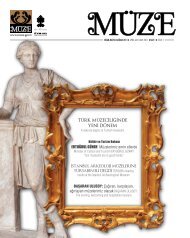GAZİANTEP ZEUGMA MOZAİK MÜZESİ
GAZİANTEP ZEUGMA MOZAİK MÜZESİ
GAZİANTEP ZEUGMA MOZAİK MÜZESİ
You also want an ePaper? Increase the reach of your titles
YUMPU automatically turns print PDFs into web optimized ePapers that Google loves.
İstanbul... Balkanlardan Kuzey Afrika’ya kadar bütün Doğu Akdeniz’i<br />
kaplayan imparatorlukların başkenti, Türkiye Cumhuriyeti’nin en kalabalık,<br />
en zengin ve en büyük ve en canlı kenti. Ünlü tarihçi Stefanos<br />
Yerasimos, ‘İstanbul: İmparatorluklar Başkenti isimli’ eserinde, işte<br />
bu kenti anlatıyor. Ama, öyküsü anlatılan bir kentin çok ötesinde.<br />
Yerasimos, sayısız uygarlığın hayali / hedefi olan İstanbul üzerinden<br />
muazzam bir tarih yolculuğu yapıyor, yaptırıyor. Bu toprakları<br />
vazgeçilmez kılan tüm olayların, kişilerin, yapıların ve inançların izini<br />
sürüyor.<br />
Kitap, bir Yunan kolonisi olarak kurulan Byzantion ile başlıyor.<br />
Bu koloni kentinin Doğu Roma İmparatorluğu’nun başkenti<br />
Konstantinapolis’e, ardından da Osmanlı İmparatorluğu’nun payitahtı<br />
İstanbul’a dönüşmesini; Osmanlı ve İslam kimliği ile tanışmasının<br />
öyküsünü, akademik araştırma kimliğini yitirmeyen sürükleyici<br />
bir dille anlatıyor.<br />
Byzantion, Konstantinapolis ve İstanbul’un iç içe geçen 16 yüzyıllık<br />
öyküsüne, anıt yapıların mimari detayları, tarihçeleri ve<br />
etraflarında şekillenen mitler, efsaneler eşlik ediyor. Okuyucu<br />
sayfalar arasında gezinirken, antik dünyanın çöküşüne ve Ortaçağ<br />
Konstantinapolis’inin gelişmesine tanıklık ediyor. Osmanlı’nın<br />
görkemine, Topkapı Sarayı’nın pencerelerinden bakıyor, Osmanlı’yı<br />
Osmanlı yapan kültürel, dini ve sanatsal öğelerin izini sürüyor.<br />
Tarih Vakfı Yayınları’ndan çıkan Stefanos Yerasimos imzalı 400 sayfalık kitabın<br />
satış fiyatı 150 TL.<br />
ESKİ DOST STEFANOS YERASİMOS<br />
Mimar, şehirci ve tarihçi Stefanos Yerasimos, 1942’de İstanbul’da<br />
doğdu. 1966’dan aramızdan ayrıldığı 2005’e kadar çoğunlukla<br />
Fransa’da yaşayan ve Paris VIII Üniversitesi’nde ders veren Yerasimos,<br />
1994-1999 yılları arasında İstanbul Fransız Anadolu Araştırmaları<br />
Enstitüsü’nün müdürlüğünü ve 1996-2000 arasında Tarih Vakfı<br />
Yönetim Kurulu Üyeliği yaptı.<br />
Marko Polo, İbn Battuta, Jean Chardin, Pierre de Tournefort’un<br />
yapıtları dahil, birçok seyahatnameyi yayına hazırlayan Yerasimos,<br />
Demeures Ottomanes en Turquie, Questions d’Orient, İstanbul,<br />
la Mosquée de Soliman, Azgelişmişlik Sürecinde Türkiye, Kurtuluş<br />
Savaşı’nda Türk-Sovyet İlişkileri, Kostantiniye ve Ayasofya Efsane-<br />
İstanbul... the capital of Eastern Mediterranean empires stretching from<br />
the Balkans to Northern Africa, the most populated, the richest, the<br />
biggest and the liveliest city of the Republic of Turkey. That is the city<br />
Stefanos Yerasimos tells us about in his book, “İstanbul, capital of<br />
Empires”. It is definitely more than a simple account on a city.<br />
Yerasimos engages us on an impressive historical journey via the<br />
description of İstanbul’s history. He offers the reader the traces of all<br />
the events, personalities, monuments and faiths which made İstanbul<br />
irreplaceable. He provides us a closer understanding on the reasons of<br />
the choice of the city as their capital by various civilizations.<br />
The book starts with the establishment of Byzantion as a Greek colony.<br />
Then, the author narrates in a fascinating style, yet respectful of the<br />
academic research character of his work, how this colony grew into<br />
becoming Konstantinoupolis (Constantinople), capital of the Eastern<br />
Roman Empire, how it expanded to become İstanbul, the capital city of<br />
the Ottoman Empire; describes the story of the acquaintance of the city<br />
with the Ottoman and Islamic identity.<br />
Architectural particularities of the various monumental structures<br />
adorning the city, their history and the popular myths and legends<br />
surrounding them ornament the intertwined history of Byzantion,<br />
Constantinople and İstanbul together developing in a time span of 16<br />
centuries. The reader witnesses the end of the Antique Age, the<br />
development of medieval Constantinople, admires the glory of the<br />
Ottoman Empire through the windows of the Topkapı Palace, discovers<br />
the origin of the cultural, religious and artistic characteristics<br />
representing the Ottoman civilization.<br />
Published by ‘Tarih Vakfı Yayınları’ (History Foundation Publishing), the sale price<br />
of the 400 pages book by Stefanos Yerasimos is 150,- TL (Turkish Pounds).<br />
leri, Milliyetler ve Sınırlar, Balkanlar, Kafkasya ve Ortadoğu, Sultan<br />
Sofraları: 15. ve 16. Yüzyılda Osmanlı Saray Mutfağı ve Süleymaniye<br />
isimli kitapların da yazarıdır.<br />
Old friend Stefanos Yerasimos<br />
Stefanos Yerasimos was one of the prominent historians portraying<br />
Turkey’s past and recent history with great accuracy. He was born on this<br />
soil. Architect, city planner and historian, Stefanos Yerasimos was born in<br />
1942 in İstanbul. He lived mostly in France from1966 until his demise in<br />
2005 and lectured at the ‘Université Paris VIII’. He served as the Director<br />
of the French Institute of Anatolian Studies in İstanbul from 1994 to 1999<br />
and was Member of the Governing Board of the History Foundation from<br />
1996 to 2000.<br />
Yerasimos was the editor of various old travel accounts, including those of<br />
Marco Polo, Ibn Battuta, Jean Chardin, Pierre de Tournefort. He is the<br />
author of several books in French and Turkish languages such as Demeures<br />
Ottomanes en Turquie, Question d’Orient, İstanbul, la Mosquée de<br />
Soliman, Azgelişmişlik Sürecinde Türkiye (Turkey in the Process of<br />
Underdevelopment), Kurtuluş Savaşında Türk-Sovyet İlişkileri (Turkish-<br />
Soviet Relations during the War of Liberation), Konstantiniye ve Ayasofya<br />
Efsaneleri (The Constantinia and Hagia Sophia Myths), Milliyetler ve<br />
Sınırlar (Nationalities and Borders), Balkanlar, Kafkasya ve Ortadoğu<br />
(The Balkans, the Caucasus and the Middle East), Sultan Sofraları : 15. ve<br />
16. Yüzyılda Osmanlı Saray Mutfağı (Dinner Tables of the Sultans :<br />
Culinary Art of the Ottoman Court in the 15 th And 16 th Centuries) and<br />
Süleymaniye (Suleiman’s Mosque).<br />
63


